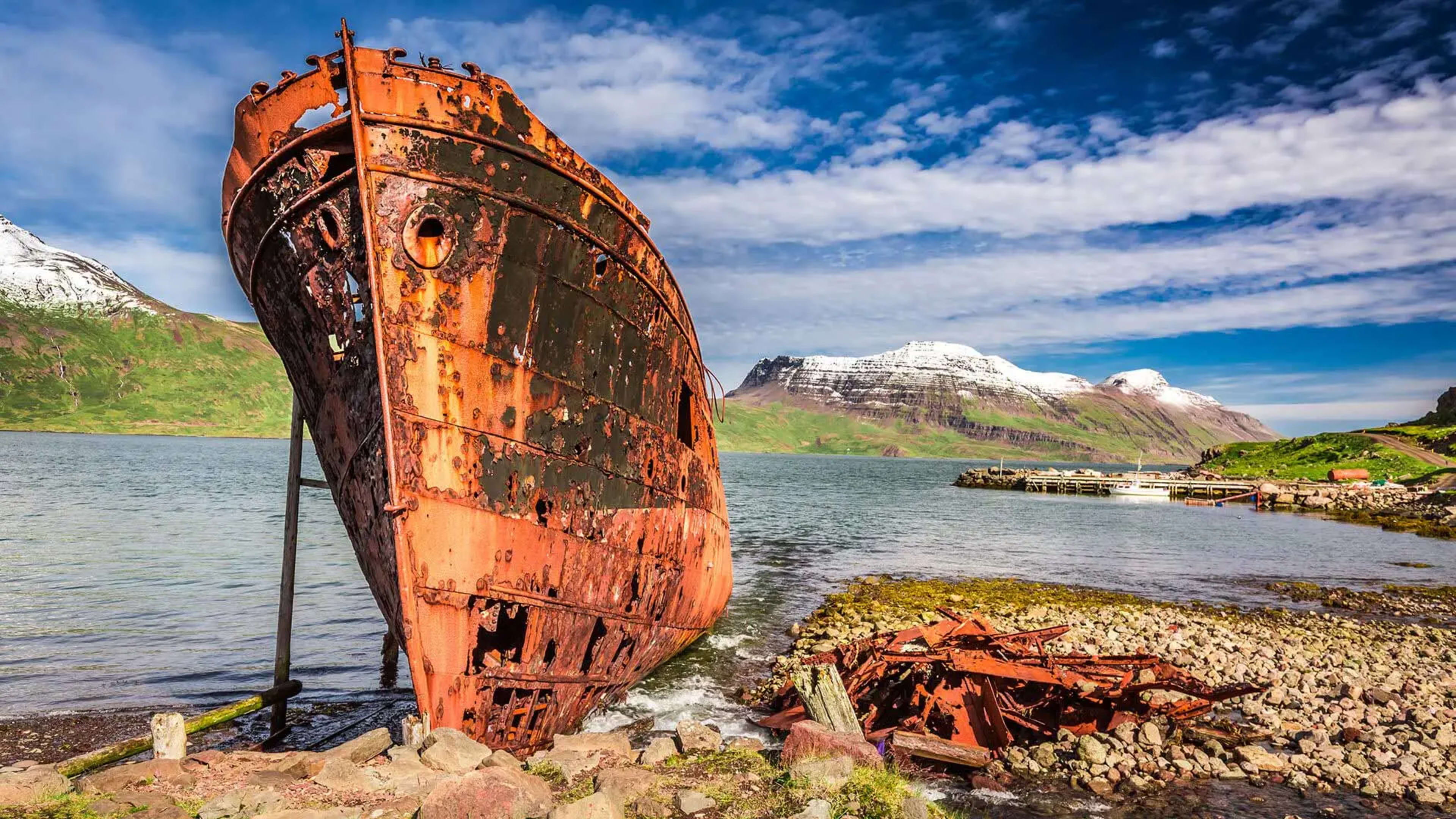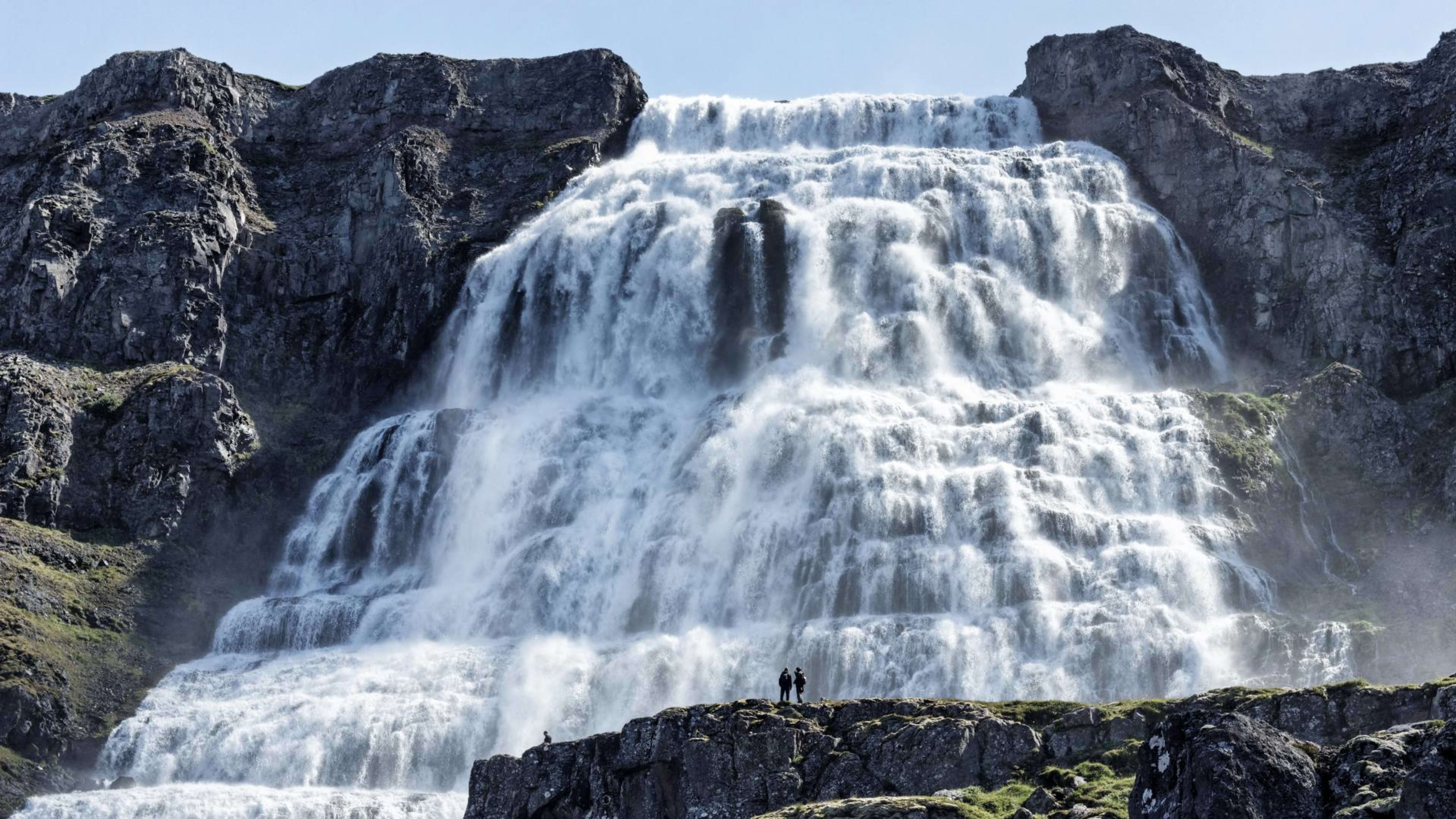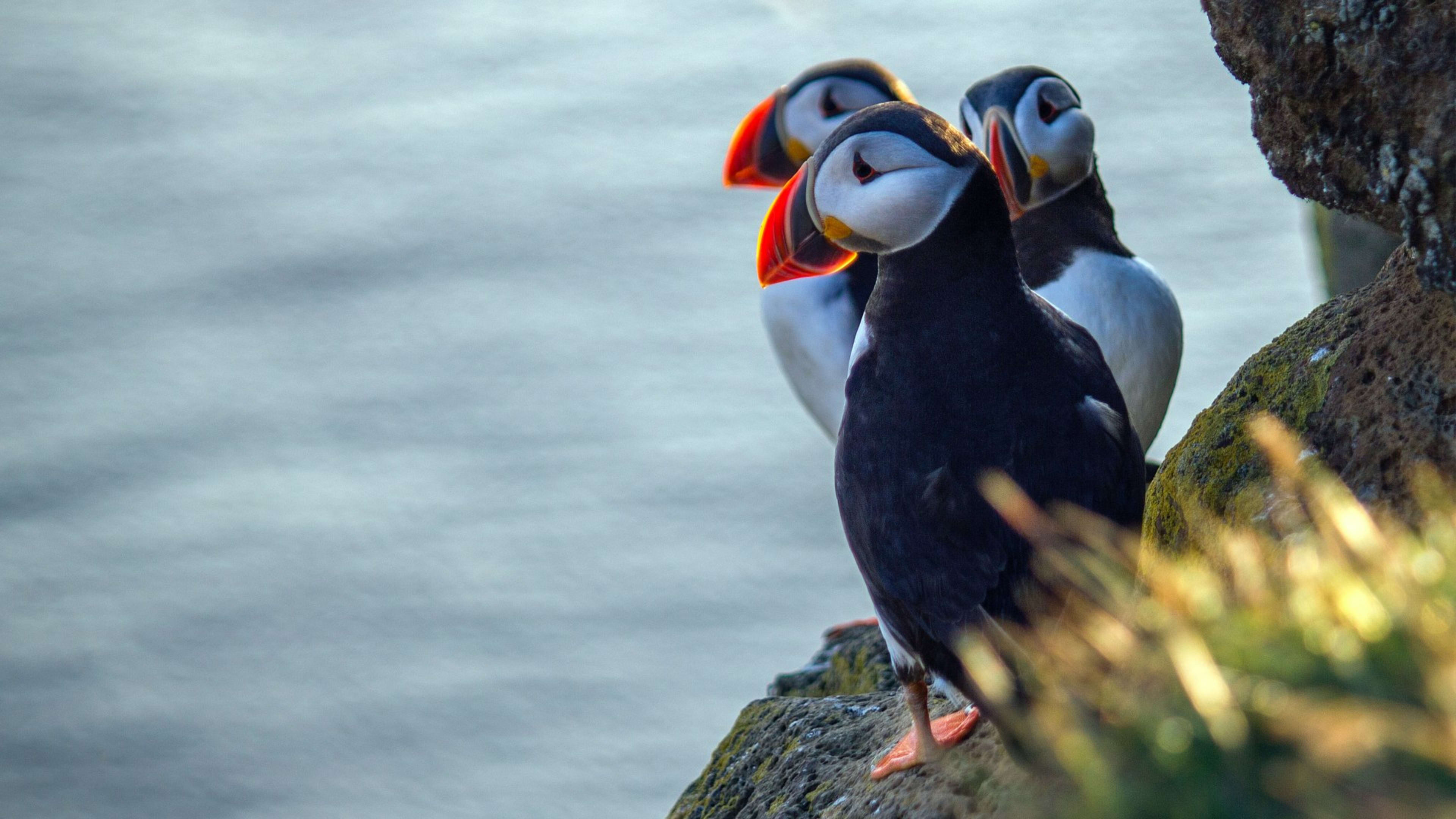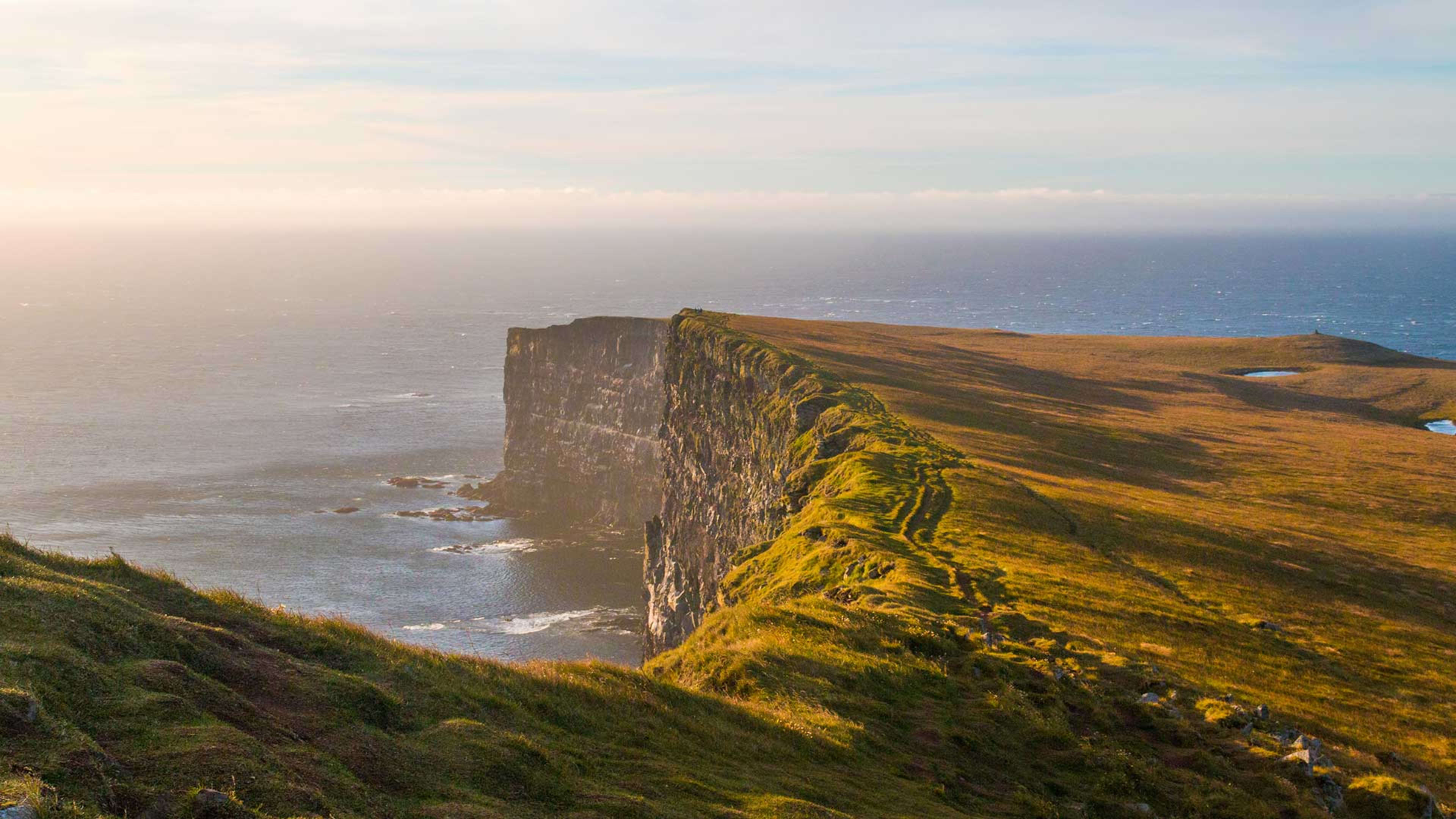The Westfjords in Iceland are one of the country’s lesser-visited regions. Due to their remoteness, they’re easy to pass by if you stick to Iceland’s famous Ring Road. But with their incredible waterfalls, quaint villages, and unspoiled wilderness, the Westfjords are definitely worth the detour.
As the name suggests, the region is located in the northwest of Iceland and studded with incredible deep fjords. The Westfjords are one of the oldest parts of the country geologically, so the landscape there is quite different to what you’ll find in the rest of Iceland.
The best way to experience the Westfjords is by car. As you cruise down the region’s winding, coast-hugging roads, you’ll feel deeply connected to both land and sea.
- See the Westfjords on an Iceland summer vacation.
Just imagine rolling down the window and breathing in the fresh ocean breeze as the sun sets over the North Atlantic. If you’re lucky, you might even catch sight of a distant whale popping its head up, or puffins nesting in giant sea cliffs.
So on your road trip to Iceland, why not take a turn-off to explore the Westfjords?
What to see and do in the Westfjords

With Lonely Planet featuring the Westfjords as one of its top destinations for 2022, you might well be wondering what the deal is with this remote corner of the world. On a tour of Iceland’s Westfjords you can:
- Marvel at the awesome Dynjandi waterfall, the tallest in the region, and its neighbors
- Visit the deserted Hornstrandir region and explore the wilderness
- See puffins at the Látrabjarg sea cliffs
- Dip into the hot tubs and swimming pools at Drangsnes, Laugarnes, and Hellulaug
- Wander the quaint streets of Ísafjörður
- Learn about Iceland’s seafaring history at the Ósvör museum in Bolungarvík
- Hike the Sandafell mountain
- Explore the abandoned village of Djúpavík
- Find out all about Arctic foxes at the Arctic Fox Center in Súðavík
One of the best things about visiting the Westfjords is the fact that it’s off the beaten track. Many people skip past it, so it’s a great place to escape the crowds and experience true wilderness.
Best places to visit in the Westfjords
If you’re still wondering whether you should explore the Westfjords, check out our picks of the 5 best places to hit in the region.
1. Hornstrandir

This remote area of the Westfjords is home to a wild nature reserve where Arctic foxes roam free! This peninsula at the very north of the region is one of Iceland’s most isolated areas.
Uninhabited since the 1950s, Hornstrandir was once home to small fishing villages and farmsteads. The most famous of these is Hesteyri. Accessible by boat from Ísafjörður, the capital of the Westfjords, Hesteyri is a great starting point for exploring Hornstrandir.
It also features in the Icelandic film Ég man þig (I Remember You), adapted from the crime thriller of the same name by author Yrsa Sigurðardóttir. In this story, ghostly residents of Hesteyri haunt a group of travelers renovating a summer house!
- Get more off-the-beaten-track ideas for Iceland in summer.

The real star of the Hornstrandir Nature Reserve though is the wildlife. Arctic foxes have claimed the territory as their own and can be seen all over. Then there are the breathtaking cliffs, home to thousands of seabirds including puffins, fulmars, and kittiwakes.
- Learn more about Icelandic wildlife with our nature & landscape guide.
It’s important to bear in mind that Hornstrandir is a tricky-to-reach destination. There are no roads to the area, so if you plan to visit this part of Iceland then you should be prepared to journey by boat.
2. Látrabjarg cliffs and Rauðisandur beach

Found at the western extreme of the Westfjords, the Látrabjarg sea cliffs are famous for pretty much one thing: puffins! You can see hundreds of these iconic red, orange, and black seabirds nesting in the cliffs’ rocky outcrops.
Of course, you won’t just see puffins, but dozens of other seabird species too. It’s quite incredible watching them thrive in what seems like such a harsh and unforgiving environment.
And you’ll get plenty of chances to spot them too. Látrabjarg is Iceland’s longest seabird cliff, in fact it’s over 14 km long.
- Explore the Látrabjarg cliffs on an Iceland self-drive tour.
There’s an ancient Icelandic tradition, called eggjatínsla, of abseiling over the cliff edge to collect bird eggs. These would have been an important food source back in the day.

About 1 hour’s drive back from Látrabjarg is the Rauðisandur (or Rauðasandur) beach. Although Iceland is known for its black sand beaches, this one is actually red (its Icelandic name means “Red Sand”).
Along with the nearby Örlygshöfn beach, you’ll definitely want to stop off here for some awesome snaps!
3. Dynjandi waterfall

At 100 meters high, Dynjandi is the tallest waterfall in the Westfjords. Dynjandi is instantly recognizable thanks to its resemblance to a thin bridal veil draped over the side of the Arnarfjörður fjord.
Dynjandi flows into the Dynjandisá river, which breaks into six more waterfalls as it rolls down the mountainside towards the sea. You can spot these as you make your way up the gravel path.

The hike up to Dynjandi only takes around 15–20 minutes, and is well worth it for the sight of one of the most spectacular waterfalls in Iceland.
You can get to Dynjandi via road 60, which runs from Ísafjörður to Route 1 (the Ring Road).
4. Ísafjörður
The small town of Ísafjörður is in fact the largest in the Westfjords, making it the unofficial capital of the region. After driving through the vast spotless landscape for hours, getting to Ísafjörður feels like arriving in a huge metropolis.
It’s definitely worth spending an afternoon or whole day exploring the quaint streets of the town. You’ll find a handful of cozy restaurants and cafés in traditional 18th-century timber houses, along with cute bookshops.
Then there are the museums, including the Ísafjörður Culture House and the Hversdagssafn (Museum of Daily Life). Ísafjörður is also known for its musical connections, with its music school, and status as the host of the Aldrei fór ég suður (“I Never Went South”) rock festival.

The layout of Ísafjörður is quite unusual compared to other Icelandic towns. It sits almost entirely on a spit of sand that juts out into the middle of the fjord, as the surrounding mountainside is too steep to build on.
You can’t help but feel the looming presence of the mountains as you wander around. In fact, they’re so tall that they block out the sun in the depths of winter. When the sun finally reaches back over the mountaintops on 23 January each year, the locals celebrate with coffee and cake!
5. Flatey
Flatey (meaning “Flat Island”) is one of thousands of small islands in the Breiðafjörður bay. And whilst not technically part of the Westfjords, the island is easily accessible by the Baldur ferry from Brjánslækur in the south of the region.
But what makes it worth visiting? Although Flatey is no longer inhabited all year round, it was once an important cultural center thanks to its monastery founded in the 12th century.
Even though the monastery is long gone, you can still see its legacy in the island’s church. Its ornate ceiling fresco was painted by artists in the 1960s and tells the history of the island.

As you wander between the well-kept wooden buildings – including the library (the oldest in Iceland) and local bar – you’ll easily start to fall in love with the island’s charm.
But more than that, Flatey just has a particular vibe about it. Perhaps it’s the island’s relative isolation, or the dozens of species of birds that nest on the thousands of skerries in Breiðafjörður. In the summertime, locals gently collect fallen feathers from the local eider ducks.
The island is edged by beautiful beaches, some dotted with abandoned fishing boats that show you what life on Flatey was like in times past. You’ll also notice that there aren’t any vehicles, apart from a tractor or two used to move supplies about.
And like the Icelanders that come back summer after summer, you’ll leave Flatey with a warm fuzzy feeling you can’t quite put your finger on.
When to visit the Westfjords

The Westfjords are a mountainous region that experiences heavy snowfall in the wintertime, so early to late summer (May–September) is definitely the best time to go. That way you can be sure that roads will be clear and accessible, and that attractions will be open.
- Discover what else there is to do in summer in Iceland.
You can also visit in the early and late autumn, before the first heavy snowfall. We wouldn’t recommend a trip to the Westfjords in the winter or early spring though, as certain roads will close and driving can get quite tricky.
- Find out why you should visit Iceland in the fall.
How to get to the Westfjords
To get around the Westfjords, you’ll need a set of wheels. Knowing this, it makes sense to drive to the Westfjords too. The journey takes about 2–3 hours by car from the capital Reykjavík, and about 3–4 hours from Akureyri in North Iceland.
The Westfjords Way is a new touring route that opened in 2020. Centered on the 60 and 61 roads, the majority of this route follows the coast. You’ll also pass through some of the region’s famous tunnels, including its newest, Dýrafjarðargöng.
When heading north on the Ring Road, turn off onto route 60 if you want to drive the south coast way first. The other option is to continue further up the Ring Road to route 68, which takes you along the winding northern coastline.
- Feel like seeing more of Iceland? Check out these Iceland Ring Road packages.

One good thing to know is that some attractions in the Westfjords are only accessible via gravel roads. These are generally not a problem, but you should drive more slowly and look out for potholes.
You might find it easier to navigate the gravel roads in a larger car such as a jeep. That way you’ll be higher up off the road for a better view, and will have better suspension for a more comfortable ride.
- See what kind of rental cars are available in Iceland.
- Get the lowdown on driving with our ultimate guide to renting a car in Iceland.
You could also fly to the Westfjords. There are daily flights to the region’s largest town, Ísafjörður, from Reykjavík Domestic Airport. Whilst this is a fast way to reach the Westfjords, you’ll be limited to exploring Ísafjörður unless you rent a car once you land.
With this in mind, we recommend driving to the Westfjords from Reykjavík. That way you’ll have a greater choice of cars and itineraries. You’ll get to see some epic scenery on the journey up, including the famous Snæfellsnes peninsula.
Planning your Westfjords adventure
When planning your Westfjords itinerary, it’s good to have an idea of how long you’ll need to truly enjoy the region. You should also think about whether you want to focus just on the Westfjords or explore the rest of Iceland too.
As the roads are winding (but incredibly scenic), it can take longer than you might think to get from one place to the next in the Westfjords. We recommend spending at least 3–4 days here so you can enjoy it without feeling rushed.
If you want to see the rest of the country too, a trip of 7 days to 11 days in total allows you to pack in a lot at a reasonable pace.
In the south of Iceland for example, you can dip in the Blue Lagoon, explore the lava fields of the Reykjanes peninsula, and marvel at bubbling hot springs and geysers. If these are must-sees for you, then a longer trip is definitely the way to go!
- Learn more about the Blue Lagoon and other pools in our hot spring guide.
At Iceland Tours, we offer a range of self-drive packages that cover the Westfjords. These packages include a rental car, accommodation, and a detailed itinerary. So you don’t need to worry about organizing everything yourself, simply book online and we take care of the rest.
Why not browse all of our vacation packages and start getting inspired for your Westfjords Iceland adventure?





